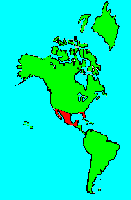SPECIES INFO
Saffron plum (Bumelia celastrina to Sideroxylon celastrinum) is found along both coastal plains in Florida and also found in eastern Mexico. This species probably also occurs in extreme south eastern Texas. The leaf blades are not very reticulate. The black fruits can be up to 1 inch long.Sideroxylon genera contains 11 species growing in greater North America which includes Hawaii, Puerto Rico, and the Virgin Islands.
Sapodilla family (Sapotaceae) contains about 1,000 species spread among just over 100 different genera. There are 29 species spread among six genera in greater North America, including Hawaii, Puerto Rico, and the Virgin Islands.
In the New World this family is found in the southern, south central and southwestern states of the United States. In Africa this is found south of the Sahara region in central and eastern Africa, and south to South Africa. This is not found in a large area of southwestern Africa. In Eurasia, this is found from India to SE Asia and into southern China. This is also found from Malaysia through most of Indonesia to New Guinea and northern Australia.
The ebony order (Ebenales) contains mostly semi-tropical and tropical trees and shrubs. The sapote (Sapotaceae), ebony (Ebenaceae), and storax (Styracaceae) families belong here.
Dicots (Dicotyledoneae Class) are the predominant group of vascular plants on earth. With the exception of the grasses (Monocots) and the Conifers (Gymnosperms), most of the larger plants that one encounters are Dicots. Dicots are characterized by having a seed with two outer shell coverings.
Some of the more primitive Dicots are the typical hardwood trees (oaks, birches, hickories, etc). The more advanced Dicots include many of the Composite (Aster) Family flowers like the Dandelion, Aster, Thistles, and Sunflowers. Although many Monocots reach a very high degree of specialization, most botanists feel that the Dicots represent the most advanced group of plants.
Seed plants (Phylum Embryophyta) are generally grouped into one large phylum containing three major classes: the Gymnosperms, the Monocots, and the Dicots. (Some scientists separate the Gymnosperms into a separate phylum and refer to the remaining plants as flowering plants or Angiospermae.)
For North American counts of the number of species in each genus and family, the primary reference has been John T. Kartesz, author of A Synonymized Checklist of the Vascular Flora of the United States, Canada, and Greenland (1994). The geographical scope of his lists include, as part of greater North America, Hawaii, Alaska, Greenland, Puerto Rico, and the Virgin Islands.
Kartesz lists 21,757 species of vascular plants comprising the ferns, gymnosperms and flowering plants as being found in greater North America (including Alaska, Hawaii, Greenland, Puerto Rico and the Virgin Islands.
There are estimates within the scientific world that about half of the listed North American seed plants were originally native with the balance being comprised of Eurasian and tropical plants that have become established.
Plant kingdom contains a large variety of different organisms including mosses, ferns, and seed plants. Most plants manufacture their energy from sunlight and water. Identification of many species is difficult in that most individual plants have characteristics that have variables based on soil moisture, soil chemistry, and sunlight.
Because of the difficulty in learning and identifying different plant groups, specialists have emerged that study only a limited group of plants. These specialists revise the taxonomy and give us detailed descriptions and ranges of the various species. Their results are published in technical journals and written with highly specialized words that apply to a specific group.
On the other hand, there are the nature publishers. These people and companies undertake the challenging task of trying to provide easy to use pictures and descriptions to identify those species.

